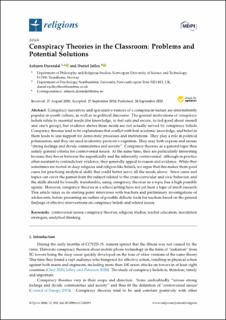| dc.contributor.author | Dyrendal, Asbjørn | |
| dc.contributor.author | Jolley, Daniel | |
| dc.date.accessioned | 2020-09-29T06:31:50Z | |
| dc.date.available | 2020-09-29T06:31:50Z | |
| dc.date.created | 2020-09-28T10:11:38Z | |
| dc.date.issued | 2020 | |
| dc.identifier.citation | Religions. 2020, 11 (10), . | en_US |
| dc.identifier.issn | 2077-1444 | |
| dc.identifier.uri | https://hdl.handle.net/11250/2680081 | |
| dc.description.abstract | Conspiracy narratives and speculative rumors of a conspiracist nature are intermittently popular in youth culture, as well as in political discourse. The general motivations of conspiracy beliefs relate to essential needs (for knowledge, to feel safe and secure, to feel good about oneself and one’s group), but evidence shows these needs are not actually served by conspiracy beliefs. Conspiracy theories tend to be explanations that conflict with best academic knowledge, and belief in them leads to less support for democratic processes and institutions. They play a role in political polarization, and they are used in identity-protective cognition. They may both express and arouse “strong feelings and divide communities and society”. Conspiracy theories as a general topic thus satisfy general criteria for controversial issues. At the same time, they are particularly interesting because they hover between the superficially and the inherently controversial: although in practice often resistant to contradictory evidence, they generally appeal to reason and evidence. While they sometimes are rooted in deep religious and religion-like beliefs, we argue that this makes them good cases for practicing analytical skills that could better serve all the needs above. Since cases and topics can cover the gamut from the subject-related to the cross-curricular and civic behavior, and the skills should be broadly transferable, using conspiracy theories as a topic has a high possible upside. However, conspiracy theories in a school setting have not yet been a topic of much research. This article takes as its starting point interviews with teachers and preliminary investigations of adolescents, before presenting an outline of possible didactic tools for teachers based on the general findings of effective interventions on conspiracy beliefs and related issues. | en_US |
| dc.language.iso | eng | en_US |
| dc.publisher | MDPI | en_US |
| dc.rights | Navngivelse 4.0 Internasjonal | * |
| dc.rights.uri | http://creativecommons.org/licenses/by/4.0/deed.no | * |
| dc.title | Conspiracy Theories in the Classroom: Problems and Potential Solutions | en_US |
| dc.type | Journal article | en_US |
| dc.type | Peer reviewed | en_US |
| dc.description.version | publishedVersion | en_US |
| dc.source.pagenumber | 11 | en_US |
| dc.source.volume | 11 | en_US |
| dc.source.journal | Religions | en_US |
| dc.source.issue | 10 | en_US |
| dc.identifier.doi | 10.3390/rel11100494 | |
| dc.identifier.cristin | 1833976 | |
| dc.description.localcode | © 2020 by the authors. Licensee MDPI, Basel, Switzerland. This article is an open access article distributed under the terms and conditions of the Creative Commons Attribution (CC BY) license (http://creativecommons.org/licenses/by/4.0/). | en_US |
| cristin.ispublished | true | |
| cristin.fulltext | postprint | |
| cristin.qualitycode | 1 | |

